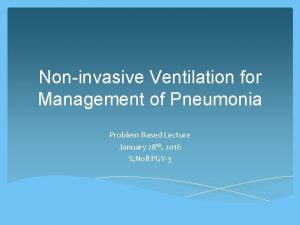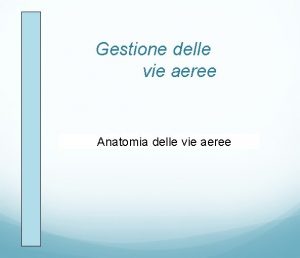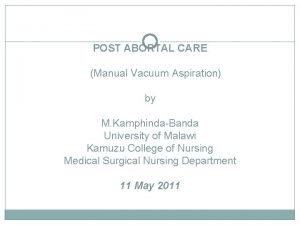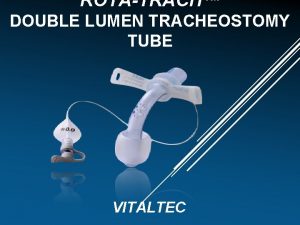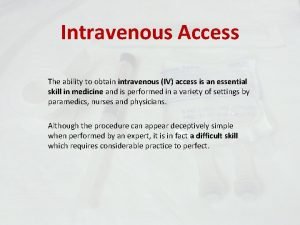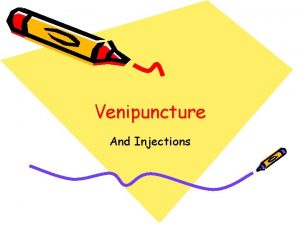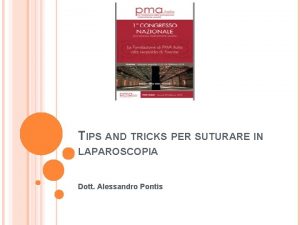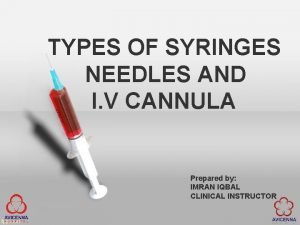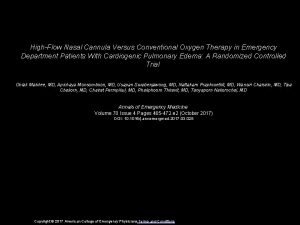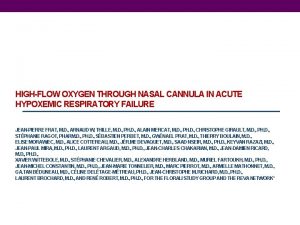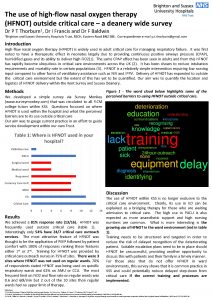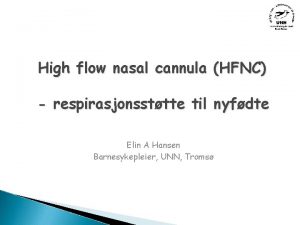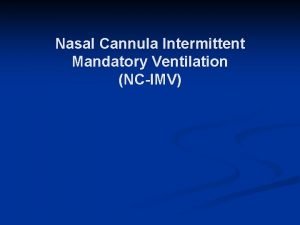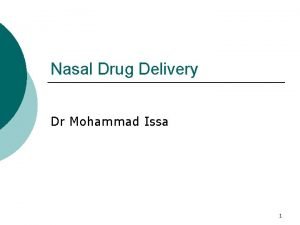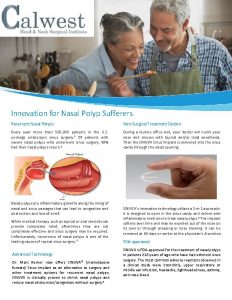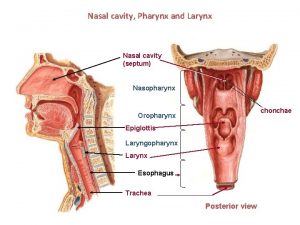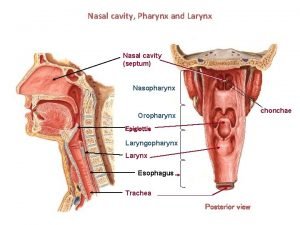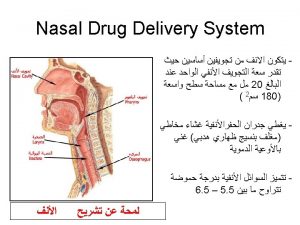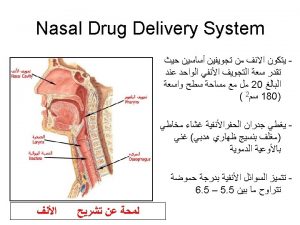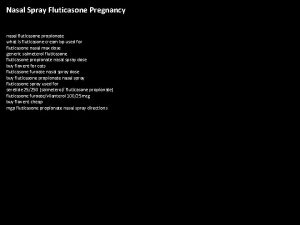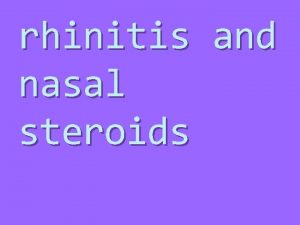HighFlow Nasal Cannula Leslie Herrmann MD lots of













































- Slides: 45

High-Flow Nasal Cannula Leslie Herrmann MD & lots of friends…

Disclaimer & Thanks • Portions of this talk were shamelessly stolen from Glenn Stryjewski, PICU physician extraordinaire, with his permission. Slides with the ANMC logo on the bottom were “borrowed” from him. • Assistance also came from Susan Romero, PICU NP extraordinaire. • Thank you to Clifton Dalton for sending me the hot-off-the-presses Life. Med recommendations. • In some places, I have over-simplified complex concepts in the interest of time. I am happy to forward Glenn’s entire talk to anyone who wants more detail. • You Tube has several helpful videos on setting up HFNC.

Historical Background at YKHC • YKHC got its first HFNC machine in 2015. • Before 2015, when we had babies and young children with impending respiratory failure, we would either intubate or humidify regular NC and go as high as 4 -5 L while awaiting arrival of Life. Med; Life. Med would then initiate HFNC. • Both options were far from ideal – often, babies were either underor over-treated.

Historical Background In 2015…

Hello. I am a HFNC machine.

What does HFNC do?

Proposed mechanisms of HFNC • Washout of nasopharyngeal dead space • Reduction of inspiratory resistance (work of breathing) by providing adequate flow • Improved mechanics by supplying adequately warmed and humidified gas • Reduction in the metabolic cost of gas conditioning • Provision of distending pressure (maybe)

Dead space • We all remember this, right? • Dead space: the portion of each tidal volume that does not take part in gas exchange (per Johns Hopkins Medicine). • At the beginning of each inspiration, the dead space is filled with expired air. (Expired air has less oxygen and more carbon dioxide than inspired air. ) • In many disease processes, physiologic dead space is increased.


Flushing out the dead space • High flow oxygen “washes out” the expired gas in the dead space. • This reduces CO 2 re-breathing. • Per Glenn, “Flushing of upper airway dead space improves ventilatory efficiency and reduces the work of breathing. ”

Proposed mechanisms of HFNC • Washout of nasopharyngeal dead space • Reduction of inspiratory resistance (work of breathing) by providing adequate flow • Improved mechanics by supplying adequately warmed and humidified gas • Reduction in the metabolic cost of gas conditioning • Provision of distending pressure (maybe)

The NOSE • Good things your nose does: • Humidifies air • Cleans/filters air • Warms air • Bad things your nose dose: • “The distensibility of the nasopharynx provides significant resistance on inspiratory relative to expiratory efforts. ” • Gets plugged up by snot

How does HFNC help the NOSE? • “HFT most likely minimizes the inspiratory resistance associated with the nasopharynx by providing nasopharyngeal gas flows that match or exceed a patient’s peak inspiratory flow. This change in resistance translates to a decrease in resistive work of breathing. ” (Dysart et al) • “Warmth and humidity keep secretions moist, improve mucociliary clearance, and inhibit inflammatory reactions and nasopulmonary bronchoconstriction reflexes triggered by cold and dry air. ” (SCH Clinical Pathway)

Proposed mechanisms of HFNC • Washout of nasopharyngeal dead space • Reduction of inspiratory resistance (work of breathing) by providing adequate flow • Improved mechanics by supplying adequately warmed and humidified gas • Reduction in the metabolic cost of gas conditioning • Provision of distending pressure (maybe)

Below the nose… • COLD + DRY air = BAD • Cold, dry air protective bronchoconstricting reflex in healthy patients as well as asthmatics • Ventilating with ambient gas (not heated or humidified) decreased pulmonary compliance and conductance • WARM + WET air = GOOD

Proposed mechanisms of HFNC • Washout of nasopharyngeal dead space • Reduction of inspiratory resistance (work of breathing) by providing adequate flow • Improved mechanics by supplying adequately warmed and humidified gas • Reduction in the metabolic cost of gas conditioning • Provision of distending pressure (maybe)

“Metabolic cost of gas conditioning” • …lots of complicated physiologic formulas about energy consumption… • Basically, it costs the body to warm and humidify air. • Supplying warm, humidified air takes some work away from the body’s workload. • Infants on warm, humidified air gain more weight than those on cold, dry air.

Proposed mechanisms of HFNC • Washout of nasopharyngeal dead space • Reduction of inspiratory resistance (work of breathing) by providing adequate flow • Improved mechanics by supplying adequately warmed and humidified gas • Reduction in the metabolic cost of gas conditioning • Provision of distending pressure (maybe)

What about PEEP? • Does HFNC provide PEEP? • This is controversial.



So…does it work?


So…does it work? • More emerging studies (with improving methodology) that show decreased rates of intubation in infants with bronchiolitis. • Anecdotally, those of us who were here pre-HFNC all agree: we intubate way less than we used to. • To quote Dr. Mc. Clure, “I haven’t friggin’ intubated anyone in over a year, at least! I need to practice! Is there anyone I can practice on? ” In short, WAY LESS THAN BEFORE.

So how do you do it?




But what if the sky is falling? • BEST PRACTICE: an RT initiates HFNC and is present until the patient is stabilized. • If we are in a worst-case-scenario situation, RED CRISIS, the sky is falling… • We will need to be able to set up and troubleshoot HFNC without an RT at bedside.

What about COVID? • There are evolving recommendations. Stay tuned – things change as frequently as Leslie has to check her temperature! • RSV isn’t going anywhere. • We may not be able to maintain many patients on ventilators. Thus, HFNC may be our best option to keep people alive. • Stay tuned for recommendations about PPE use if using HFNC.

A word about Life. Med • Life. Med has new recommendations. • In cases of confirmed or suspected COVID, they will intubate early. • In cases of negative or low suspicion for COVID, they will consider using HFNC up to 15 L.

How to set up Vapotherm • Video from the manufacturer: https: //www. youtube. com/watch? v=w. Go. RPNqs. TKs • More entertaining video from a British hospital: https: //www. youtube. com/watch? v=r. Nnpi. P 6 XEMg • Step-by-step guide attached to the unit is helpful, but uses jargon.

How to set up Vapotherm Things you need: Cartridge and Disposable Water Path (packaged together) Tubing Nasal cannula (not conventional NC) Bag of sterile water

How to set up Vapotherm 1. Select your cartridge. Lower flow cartridge delivers flow rates of 1 -8 L. Higher flow cartridge delivers flow rates of 5 -40 L. How much flow do you anticipate using?

How to set up Vapotherm 2. Plug oxygen and air into the wall.

How to set up Vapotherm 3. Plug in the machine. The machine begins in Sleep Mode. The circled light will be yellow/amber. The screen will be blank.

How to set up Vapotherm 4. Attach the cartridge to the Disposable Water Path (the big plastic thing): Pull the cylinder out of the bag. (This is the metal thing. ) Remove the rubber caps. This plugs into the Disposable Water Path and clicks in.

How to set up Vapotherm 5. Attach the tubing to the Disposable Water Path (the plastic thing). It will click into place. Open the side door to the Vapotherm unit and slide the whole thing in.

How to set up Vapotherm 6. Attach the water: Make sure the clamp on the tubing is CLOSED. Wipe the spike with an alcohol pad. Spike the bag of sterile water. Hang the bag. Open the clamp. Let the water flooooow…

How to set up Vapotherm 7. Rotate the knob. This will put the machine into Standby Mode. The screen will come on.

How to set up Vapotherm 8. Choose your settings: Flow: 0. 5 -2 L/kg Fi. O 2: usually start at 50%. Temperature: 37°

How to set up Vapotherm 9. Press the Standby button. The machine will beep. The yellow light will flash green at first. When the light is a solid green, the machine is ready for business! Check the patient end of the tubing – you should be able to hear and feel flow.

How to set up Vapotherm 10. Attach the Vapotherm nasal cannula to the baby’s face. Choose a cannula that does not occlude more than 50% of the nares.

How to set up Vapotherm 11. Wait for the temperature to get to 37°. Then attach the cannula tubing to the machine tubing. Congratulations! Your patient is now on HFNC!

 Lifemed hfnc
Lifemed hfnc High flow nasal cannula
High flow nasal cannula High-flow nasal cannula vs bipap nejm
High-flow nasal cannula vs bipap nejm Oxygen flow rate chart
Oxygen flow rate chart Nasal cannula pressure ulcer prevention
Nasal cannula pressure ulcer prevention Jon herrmann
Jon herrmann Curphy followership model
Curphy followership model Kinga herrmann
Kinga herrmann Jeanne herrmann
Jeanne herrmann Heimatlos max herrmann neiße analyse
Heimatlos max herrmann neiße analyse Stefan herrmann mtb
Stefan herrmann mtb Howard herrmann
Howard herrmann Ned herrmann
Ned herrmann Ned herrmann
Ned herrmann 4 gaya pembelajaran
4 gaya pembelajaran Line & catheter label - intravenous burette
Line & catheter label - intravenous burette Transfixation cannula
Transfixation cannula Cormack classificazione
Cormack classificazione Mva cannula sizes by color
Mva cannula sizes by color Line & catheter label - intravenous burette
Line & catheter label - intravenous burette Indications of tracheostomy
Indications of tracheostomy Laringe
Laringe Central line dilator
Central line dilator Cannula cuffiata o scuffiata
Cannula cuffiata o scuffiata Parts of cannula
Parts of cannula Iv cannula labelling
Iv cannula labelling Iv removal documentation example
Iv removal documentation example Ago cannula smiley
Ago cannula smiley Cannula sizes
Cannula sizes Concession system of southern ontario
Concession system of southern ontario There is lots of milk
There is lots of milk Fear factor tasks
Fear factor tasks Hot weather similes
Hot weather similes Regrettably these days lots of people don't have jobs
Regrettably these days lots of people don't have jobs Hots and lots
Hots and lots Nrich lots of lollies
Nrich lots of lollies Lot's wife jeffrey r holland
Lot's wife jeffrey r holland Remember lots wife
Remember lots wife Sentences with much
Sentences with much If you had lots of money what ____
If you had lots of money what ____ Hots and lots
Hots and lots 463 x 3
463 x 3 Biog lots
Biog lots A lot of / lots of
A lot of / lots of Few sayılabilir mi
Few sayılabilir mi E lots
E lots


